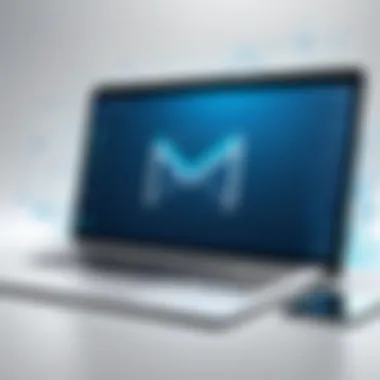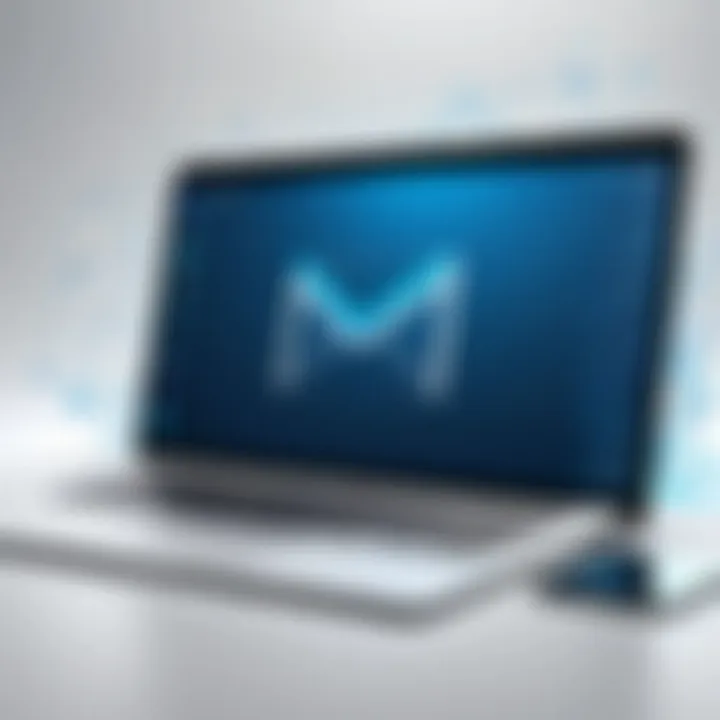Understanding Exclaimer Signatures in Business Communication


Intro
In today's digital landscape, professional communication relies heavily on clarity, consistency, and branding. One essential tool in this regard is the Exclaimer signature. These signatures serve more than just a means of identifying the sender; they encapsulate brand values, provide important information, and maintain compliance with corporate policies.
As businesses evolve, the integration of Exclaimer signatures into email communications becomes increasingly vital. Understanding their role and function can bolster brand identity while ensuring that crucial information reaches its intended audience effectively.
Software Category Overview
Definition and Importance
Exclaimer signatures are specialized email signatures designed to ensure uniformity across organizational communications. Their importance lies in their ability to create a consistent brand image and enhance professionalism. In an age where digital interaction is predominant, having a recognizable signature can distinguish a company from its competitors.
With the rise of remote work and digital exchanges, ensuring that all employees represent the company similarly is essential for fostering a cohesive corporate presence.
Key Characteristics
Exclaimer signatures possess several key characteristics that make them invaluable:
- Brand Consistency: They reinforce brand identity through logos, color schemes, and typography.
- Dynamic Elements: Signatures can incorporate live elements, such as promoting events or announcements directly within emails.
- Compliance Assurance: They help organizations meet legal and regulatory email signature requirements, thereby reducing risk.
- Ease of Management: Centralized control allows companies to update signatures at scale, ensuring all communications are up-to-date.
Comparative Analysis of Top Software Options
Feature Comparison
When assessing various Exclaimer signature solutions, it is crucial to compare their features. Some notable options include Exclaimer Cloud, CodeTwo Email Signatures, and ZippySig.
- Exclaimer Cloud: Offers comprehensive features, including templates, analytics, and integration with Office 365 and G Suite.
- CodeTwo Email Signatures: Enables detailed design customization and supports multiple email clients, making it versatile for different organizational needs.
- ZippySig: Known for its user-friendly interface and collaboration tools, allowing teams to create and manage signatures effortlessly.
Pricing Models
Understanding the pricing models of these solutions is important for decision-makers. While some software options follow a subscription model, others may offer one-time payment plans. Here’s a brief overview:
- Exclaimer Cloud: Subscription-based with tiered pricing depending on the number of users.
- CodeTwo Email Signatures: Typically a one-time purchase, with additional fees for updates and support.
- ZippySig: Available through monthly or annual plans, providing flexibility for various budgets.
Properly implementing Exclaimer signatures not only enhances your communication but fortifies your brand's image across all platforms.
The significance of Exclaimer signatures extends beyond mere aesthetics. They are a fundamental aspect of any organization's digital identity strategy, contributing directly to brand cohesion and regulatory compliance. Understanding the various facets of these signatures can empower organizations to leverage them more effectively.
Prologue to Exclaimer Signatures
In a world where digital communication dominates, the way organizations present themselves in email has never been more critical. Exclaimer signatures play a significant role in shaping a company’s digital identity. They are not just a formality; they serve multiple functions, including professionalism, branding, and compliance with corporate standards.
Understanding Email Signatures
An email signature provides essential information about the sender. Typically, it includes the person's name, position, company name, and contact details. However, beyond just contact information, a well-designed email signature serves as a valuable marketing tool. It fosters brand awareness and reinforces visual identity every time an email is sent. Exclaimer signatures enhance this concept by allowing organizations to create custom signatures that reflect their brand consistently across all employee communications.
The significance of email signatures extends to creating trust and recognition in a crowded marketplace. When clients see a well-structured signature, it elevates their perception of the company’s professionalism. This simple yet effective tool enables businesses to communicate effectively and maintain a coherent visual representation.
The Emergence of Exclaimer
Exclaimer emerged to solve several challenges that companies face in implementing effective email signatures. Before Exclaimer, organizations struggled with fragmented or inconsistent signatures. Often, each employee created their own, leading to varied representations of the brand. Exclaimer’s solution offers centralization and control.
With Exclaimer, businesses can design and enforce email signatures from a single platform. This ensures that every outgoing email embodies the brand’s identity. Additionally, it offers features that compel compliance with legal requirements.
Exclaimer signatures also support integration with various email systems, enabling organizations to utilize this tool without extensive alterations to existing workflows. This ease of implementation makes it a go-to solution for many enterprises eager to maintain professionalism in their communication.
"Email signatures serve beyond convenience; they perform as digital ambassadors for a business, shaping impressions and trust."


The importance of Exclaimer signatures will continue to grow as organizations strive for consistency in an increasingly digital environment. By adopting standardized and customizable signatures, companies can wield their communication as a strategic asset, reinforcing their brand at every touchpoint.
Importance of Professional Email Signatures
Professional email signatures serve as a critical component of corporate communication. They function not just as a formal closure to emails but also as a tool for enhancing brand identity and ensuring compliance with various standards. Understanding their importance is essential for any organization looking to solidify its reputation and maintain consistency in messaging.
One of the primary roles of an email signature is to act as a digital business card. It provides essential information about the sender, including their name, title, company, and contact details. This simple inclusion helps recipients recognize the sender easily and enhances the overall professionalism of communications. A well-designed signature becomes part of the brand's visual identity and can have a lasting impact on the viewer.
In addition to sheer recognition, professional email signatures also contribute to brand awareness. Each time an email is sent, the signature is shared. This increases exposure to the company’s branding elements, such as logos, colors, and even calls to action. Each signature can reinforce the brand's message, promoting a unified image across different departments and individuals. A study suggested that consistent branding can increase revenue by up to 23%.
Beyond branding, email signatures also encapsulate important legal information. Many industries are subject to regulatory standards that require specific disclaimers or notices to be included in official correspondence. This ensures that organizations meet compliance requirements and manage potential legal risks effectively. Inconsistent or missing information can lead to misunderstandings, and worse, legal repercussions.
With the rise of remote communication, the significance of professional email signatures has only grown. They represent the face of the organization, make initial impressions, and offer contact points to recipients. As such, investing time in designing and implementing effective email signatures through tools like Exclaimer can yield benefits that extend far beyond email communications.
"A well-crafted email signature is not just a formality; it's an opportunity to communicate a message, promote the brand, and maintain compliance with industry standards."
Key Features of Exclaimer Signatures
Exclaimer signatures are not just simple email footers; they serve as a critical component of professional communication. These signatures enhance branding, provide essential information, and promote legal compliance. Understanding the key features of Exclaimer signatures allows organizations to leverage their full potential.
Customization Options
One of the standout features of Exclaimer signatures is the high degree of customization they offer. Organizations can tailor email signatures to reflect their brand identity. This includes color schemes, fonts, and logos that align with company branding. Customization extends beyond aesthetics. It also includes the ability to include specific contact details such as phone numbers, job titles, and departmental information.
Additionally, businesses can create various signature templates for different teams or communication contexts. For instance, marketing teams may have a distinct signature that emphasizes recent campaigns, while customer service might focus on contact information and quick response times. This flexibility enhances the company’s communication strategy by maintaining a unified professional appearance while fulfilling diverse operational needs.
Integration with Email Systems
Exclaimer signatures integrate seamlessly with popular email systems like Microsoft Outlook and Google Workspace. This integration is crucial for organizations seeking efficiency. By automatically applying signatures to outgoing emails, Exclaimer eliminates manual errors and ensures consistency across all communication.
Moreover, organizations can manage signatures centrally. This means updates made to signatures—whether it's a change in the company logo or an addition of legal disclaimers—can be executed instantly without the need for individual users to manually alter their settings. Such streamlined integration simplifies the overall management of email signatures and reinforces brand messaging consistently through every email.
Analytics and Tracking Capabilities
The ability to analyze and track the performance of email signatures is another significant feature of Exclaimer. This functionality provides insight into how often signatures are viewed and interacted with. By employing tracking links or including UTM parameters, businesses can measure engagement levels arising from specific campaigns directed through email communication.
"Using analytics, organizations can gain valuable insights into customer interaction and optimize their strategies accordingly."
Furthermore, this data supports decision-making processes. Companies can assess the effectiveness of email signatures as marketing tools and adjust designs or messages based on engagement metrics. In an increasingly data-driven landscape, these analytics capabilities transform standard email signatures into valuable assets that contribute to professional communication and overall marketing efforts.
In summary, understanding the key features of Exclaimer signatures reveals their powerful role in professional communication. From customizable designs to seamless integration and insightful analytics, these signatures provide a multifaceted approach to enhancing branding and communication efforts.
Best Practices for Deploying Exclaimer Signatures
Effectively deploying Exclaimer signatures is vital for any organization that wants to enhance its professional communications. These signatures carry the potential to significantly bolster brand identity and convey essential information. However, certain best practices must be followed to ensure these signatures serve their intended purpose. This section discusses the crucial elements that contribute to the successful implementation of Exclaimer signatures, focusing on design considerations, consistency, and a diligent testing and review process.
Design Considerations
When creating Exclaimer signatures, design plays a key role. A well-designed signature reflects the company's brand and conveys professionalism. First, it is crucial to follow brand guidelines. This includes using the right colors, logo, and fonts that align with the corporate identity. A signature should not be overly complicated; simplicity aids readability.
- Font Choices: Use easy-to-read fonts like Arial or Verdana. Avoid decorative fonts, as they can distract from the message.
- Logo Placement: Ensure that the logo is present but not overwhelming. It should link back to the website for better brand engagement.
- Contact Information: Clearly display contact details. This includes phone numbers, email addresses, and social media accounts that can foster customer interaction.
In essence, the design should be modern, professional, and functional, providing all necessary information at a glance while enhancing the company's image.
Consistency Across User Base


Achieving consistency across the user base is paramount for maintaining a cohesive brand image. When employees use different signature formats, it can confuse recipients and dilute the brand message. To promote uniformity:
- Establish Guidelines: Develop comprehensive guidelines detailing how the Exclaimer signature should look. This includes specifications on font size, color codes, and logo dimensions.
- Centralized Management: Implement a centralized system where signatures are controlled and updated from a singular platform. This reduces the chances of discrepancies occurring among different employees.
- Regular Updates: As branding evolves or when updates are needed, ensure that changes are communicated promptly to all employees. Keeping signatures current strengthens brand coherence.
Testing and Review Process
A robust testing and review process cannot be overlooked. Before full deployment, it is essential to evaluate how the signatures display in multiple email clients and devices. This step ensures a professional appearance across various platforms.
- Cross-Client Testing: Test the signatures on different email clients like Outlook, Gmail, and Apple Mail. This guards against rendering issues.
- Review Feedback: Encourage user feedback post-deployment. This can spotlight bugs or problems that were not evident during initial tests.
- Iterative Improvements: Be ready to revise the signatures based on collected feedback. Regular updates ensure the signatures remain effective and eye-catching.
A thoughtful approach to the design, consistency, and evaluation of Exclaimer signatures is essential for maximizing their impact in professional communications.
In summary, the successful deployment of Exclaimer signatures is more than a technical task; it is a strategic venture. By adhering to these best practices, organizations can enhance their communication efforts, project a unified brand, and ultimately foster better connections with their audience.
Challenges in Implementing Exclaimer Signatures
Implementing Exclaimer signatures comes with several challenges that organizations must navigate. Understanding these challenges is crucial to ensure a smooth deployment process and to maximize the benefits that come with a cohesive signature system. Common obstacles include technical difficulties, resistance from users, and issues with maintaining consistent brand messaging.
Technical Difficulties
Technical difficulties can hinder the effective integration of Exclaimer signatures into an organization’s email system. Various factors are at play here. For one, compatibility with existing email platforms such as Microsoft Exchange or Office 365 is critical. Organizations may face integration problems if their email infrastructure is outdated or customized in a unique way.
Furthermore, updates or changes in email systems can result in technical glitches, which leads to inconsistencies in how signatures appear to recipients. For example, an email client may not fully support the features of Exclaimer, causing formatting issues. This can impact professionalism and create confusion for both senders and receivers. Addressing these technical issues requires proper planning and testing. Organizations should allocate sufficient resources to troubleshoot potential challenges during the setup phase.
User Resistance and Adaptation
The human element is a vital consideration when implementing Exclaimer signatures. Resistance from users is a common hurdle that may delay or derail the deployment process. Some individuals may feel hesitant to adopt a new system, particularly if they are accustomed to their personal email signature styles.
Training and clear communication are essential to mitigate resistance. Educational sessions that outline the benefits of standardized signatures can help in securing buy-in from employees. Companies should encourage user feedback during the adaptation phase, allowing employees to express concerns and suggest improvements. This two-way communication fosters an environment of cooperation and reduces resistance.
Inconsistent Brand Messaging
Another significant challenge is ensuring consistent brand messaging across all signatures. When multiple users create their own signatures, even within the same organization, discrepancies arise in design and content. Subtle variations such as font choice, color schemes, and taglines can dilute a brand's identity and confuse recipients.
To prevent this inconsistency, organizations must establish clear guidelines for signature design and content. A centralized management approach with Exclaimer allows for standardized signatures that reflect the organization’s brand accurately. Regular audits can be implemented to ensure compliance with these brand standards across the organization’s email communication.
Standardized email signatures can significantly impact how the brand is perceived, emphasizing credibility and professionalism.
By addressing these challenges, organizations can leverage the full potential of Exclaimer signatures. A thoughtful approach to implementation that anticipates technical, human, and branding issues will smooth the journey towards a more cohesive and professional communication framework.
Case Studies: Successful Exclaimer Signature Implementations
In the realm of professional communication, understanding how organizations successfully implement Exclaimer signatures can provide valuable insights. These case studies illuminate specific strategies that companies employ, showcasing the benefits and unique considerations involved. By examining real-world examples, we can grasp the practical significance of Exclaimer signatures in enhancing brand identity and facilitating consistent messaging.
Corporate Sector Examples
Within the corporate sector, the strategic utilization of Exclaimer signatures has shown how organizations can unify their branding efforts while also ensuring compliance with organizational standards. For instance, a leading financial institution adopted Exclaimer signatures as part of a broader digital transformation initiative. By leveraging customized email signatures across the organization, the company could ensure that all communication carried a consistent visual identity, which in turn reinforced brand trust among clients and stakeholders.
Moreover, this financial firm integrated their email signatures with specific legal disclaimers and marketing graphics. The result was twofold: enhanced legal compliance and a more impactful engagement with clients. The analytics provided by Exclaimer allowed the company to measure engagement metrics, leading to insightful adjustments in marketing strategies based on user interactions.
Key takeaways from this corporate example include:
- Brand Consistency: A uniform email signature reinforces brand identity.
- Legal Compliance: Incorporating necessary disclaimers is simplified.
- Data Insights: Analytics provide valuable data to refine communication strategies.


Nonprofit and Educational Institutions
Nonprofit organizations and educational institutions have also seen the benefits of implementing Exclaimer signatures. One notable example is a prominent nonprofit focused on environmental conservation. They deployed their Exclaimer signature to not only promote the organization's mission but also to drive fundraising efforts by including calls to action and links to donation pages directly within their signatures.
In this case, the integration of visually appealing designs and clear messaging significantly increased the visibility of their campaigns. Reports indicated a measurable increase in web traffic and donations, attributed directly to signature-driven campaigns. Similarly, an educational institution utilized Exclaimer signatures to promote events, linking each signature to relevant pages for prospective students and donors.
Insights gathered from these implementations in the nonprofit sector highlight:
- Fundraising Support: Email signatures can function as engagement tools for fundraising.
- Event Promotion: Direct links to events enhance visibility among targeted audiences.
- Community Building: A strong digital presence supports community outreach and involvement.
In summary, the case studies from both the corporate and nonprofit spheres illustrate not only the effective use of Exclaimer signatures but also their potential to amplify communication efforts across varying sectors. Organizations that invest in these tools position themselves for greater brand recognition and operational efficiencies.
Future Trends in Email Signatures
Email signatures continuously evolve as businesses adapt to new communication norms and technologies. Understanding future trends in email signatures is essential for organizations aiming to stay competitive. Exclaimer signatures are no exception. They will likely reflect advancements in personalization, integration, and compliance as organizations streamline communication.
Among the emerging trends, technology plays a critical role. Organizations could harness innovations such as artificial intelligence to automate the creation of tailored signatures. AI can analyze email contents, audience profiles, and communication contexts, enabling signatures to adapt accordingly. This advancement could enhance engagement without compromising professionalism.
Another significant trend involves the integration of email signatures with various platforms. As businesses depend on collaboration tools like Microsoft Teams and Slack, including dynamic signatures that work seamlessly across platforms could improve consistency. This integration allows employees to maintain a unified brand presence regardless of the communication medium.
Benefits of keeping up with future trends in email signatures include:
- Increased Efficiency: Automation can save time for staff members by reducing manual entering of details.
- Enhanced Brand Identity: Modern signatures make branding more cohesive and recognizable.
- Adaptability: Techniques like data analytics can aid organizations in refining their communication approach based on user interaction.
As expectations evolve, so too will the functionality of email signatures. They will increasingly need to support various communication needs within global markets.
Emerging Technologies
Emerging technologies are reshaping how email signatures function. Businesses should closely observe trends in AI and automation to fully utilize their potential. By adopting these technologies, companies can create unique signatures based on user behavior and preferences.
Artificial intelligence could generate contextual signatures that align with email content. For instance, if someone is discussing a specific project, the signature could reflect relevant details like a project tagline or linked resources. This not only saves time but also increases the chances of engagement.
Beyond AI, cloud technology is essential for improving signature management. Utilizing platforms such as Office 365 or Google Workspace allows for centralized control over signatures. This capability ensures that any updates, such as logo changes or new policies, can be applied across the organization promptly, keeping brand messaging consistent.
In addition, integrating visual elements like logos or social media icons can enhance appeal. A sleek and interactive design can create a positive first impression and encourage recipients to engage further. Therefore, being aware of technological advancements is crucial for businesses wishing to modernize their communication practices.
Evolving User Expectations
The changing landscape of digital communication affects user expectations. Recent trends reflect a growing demand for personalization in professional interactions. Recipients now desire more than a basic signature—they seek relevance and authenticity in communications.
Personalized signatures strengthen relationships with clients and prospects. A customized signature reflecting the recipient's interests shows a level of investment and engagement that can positively influence decision-making. This shift toward personalization requires businesses to understand their audience better, tailoring signatures to resonate with varied demographics.
Furthermore, transparency is becoming increasingly important. Users expect companies to convey their values and mission through email signatures. This may include highlighting sustainability efforts or community involvement. A signature that reflects such ideals fosters trust among recipients and aligns with their preferences.
In summary, to meet evolving expectations, organizations must continuously assess their communication methods. The awareness of trends and changes in user preferences will enable companies to leverage Exclaimer signatures more effectively, enhancing brand perception in a fast-paced digital world.
Culmination
The conclusion serves to encapsulate the main ideas surrounding Exclaimer signatures and their critical role in professional communication. It reinforces the reasons why these digital signatures are not just an added feature, but rather an essential component to corporate identity and interaction.
Summarizing the Importance of Exclaimer Signatures
Exclaimer signatures play a significant role in how organizations present themselves digitally. They ensure consistency in branding across various types of communications, from emails to newsletters. A well-designed email signature captures essential information like the employee's name, title, and contact details, while also integrating brand elements. This integration not only helps recipients recognize the brand but also lends an air of professionalism. Moreover, these signatures can provide legal disclaimers and compliance messages, thus protecting the organization from potential liability. By providing this level of detail and professionalism, Exclaimer signatures enhance trust and credibility in professional relationships.
Encouraging Adoption and Best Practices
Adopting Exclaimer signatures is beneficial but requires careful consideration of design and implementation practices. Organizations should prioritize designing clear and effective signatures that reflect their brand identity accurately. Key best practices include:
- Establishing Consistency: All employees should use similar templates to maintain uniformity in messaging.
- Regular Updates: Regularly reviewing and updating signatures ensures that all information is current and relevant.
- Training and Support: Providing training to staff about the importance and usage of email signatures can improve compliance and effectiveness.
- Feedback Mechanism: Creating channels for feedback helps in refining signatures based on user experience and stakeholder input.
By following these guidelines, organizations can fully harness the power of Exclaimer signatures to reinforce their brand and enhance their professional communication.







